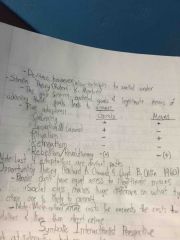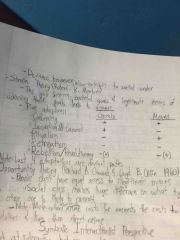![]()
![]()
![]()
Use LEFT and RIGHT arrow keys to navigate between flashcards;
Use UP and DOWN arrow keys to flip the card;
H to show hint;
A reads text to speech;
35 Cards in this Set
- Front
- Back
|
6 Elements of Social Structure |
Culture Social Class Statuses Roles Groups Institutions |
|
|
Culture |
Provides orientation to view world so ial |
|
|
Social Class |
A large number of people w/similar amounts of power/property & prestige -heavily influences our behavior, altitudes, ideas -impacts life chances |
|
|
Status |
Position in society -one can occupy several statuses at once -significance: determines how you relate to people and how people relate to u -master status: status which organizes other statuses, others see u as this |
|
|
Status inconsistency |
Occupying 2 or more statuses viewed by society as inconsistent |
|
|
Ascribed status |
Status given to us at birth or recovered involuntarily later in life |
|
|
Role expectations |
Clusters of norms that describe how a role ought to be played -Needed to ensure a smooth and predictable course of social interaction |
|
|
Role Conflict |
Contradictory expectations between two or more statuses EG: |
|
|
Role taking |
Outcome of socialization is the ability to anticipate what others expect of us & to shape our behavior accordingly |
|
|
Generalized other |
The attitude of the generalized other is the attitude of the larger community |
|
|
Agents of socialization |
People & groups that influence our self-concept, emotions, attitudes, &behavior. -occurs in 3 ways 1. Direct learning 2. Imitation/ Role modeling 3. Conditioning |
|
|
Role Strain |
Contradictory expectations in one role Doctor needs be compassionate AND professional |
|
|
Group |
2 or more people who interact frequently and share a common identity and feeling of interdependence |
|
|
3 Elements of a Group |
Sense of identity/belonging Interaction with/one another Feeling of interdependence |
|
|
Aggregate |
A bunch of people hanging around with no shared expectations |
|
|
Reference group |
Group we see as standard to evaluate ourselves |
|
|
Functionalist perspective GROUPS |
Groups meet instrumental and expressive needs |
|
|
Conflict theorists perspective GROUPS |
Focus on power relationships within groups |
|
|
Postmodernist perspective GROUPS |
Modern groups characterized by "superficial relations and a lack of depth" |
|
|
Interactionist perspective GROUPS |
Focus on how size of group influences interaction |
|
|
Webers view bureaucracy |
Pro: Most effective way to organize large formal organization Con: Rules, regulations, and emphasis one results would increasingly govern our lives |
|
|
McDonaldization main goals |
Efficiency Uniformity (Predictability) Calculability Control (quantity > quality) |
|
|
Functionalist explanation to deviance |
Caused by anomie, however deviance also contributes to social order |
|
|
Strain Thoery |

Gap between societal goals and legitimate means of achieving those goals leads to anomie |
|
|
Opportunity Theory |
People don't have equal access to illegitimate mean Social class has huge difference on what types of crimes one may commit |
|
|
Symbolic Interactionist Perspective |
Look at interactionist between people Look at some people similar situations who commit crimes and others who do not |
|
|
Differential Association |
Learn the behaviors, attitudes, methods, and techniques from those w/whom we associate Confirm to deviant groups norms, emotional connection |
|
|
Control theory |
2 control systems work against our motivation to deviate -Inner containment (controls) -internalization of norms -Outer containments (controls) -consists of people who influence is not to deviate |
|
|
Strain Thoery |

Gap between societal goals and legitimate means of achieving those goals leads to anomie |
|
|
Opportunity Theory |
People don't have equal access to illegitimate mean Social class has huge difference on what types of crimes one may commit |
|
|
Symbolic Interactionist Perspective |
Look at interactionist between people Look at some people similar situations who commit crimes and others who do not |
|
|
Differential Association |
Learn the behaviors, attitudes, methods, and techniques from those w/whom we associate Confirm to deviant groups norms, emotional connection |
|
|
Social Bond theory |
Stronger bonds are with society, stronger our inner controls are Bonds based on -Attachments -Commitments -Involvements -Beliefs Deviance occurs when push or pull towards deviance I stronger than inner and outer control systems |
|
|
Labeling Theory |
Focus on process by which some members of society determine what is deviant and then proceed to label those who are deemed deviant -Social control mechanism -3 stages of deviance: -Primary deviance (deviant but not labeled -Secondary deviance (stigmas reduce life chances -Tertiary deviance (some able to pursue deviant paths but reject label) |
|
|
Conflict perspective |
Agrees with strain theory, focus on power relationships instead of anomie Pathological effects of capitalism People in power write laws defining what is and isn't a crime Protects the properties and property Laws used to exercise control over others, judicial system used as tool of oppression |

